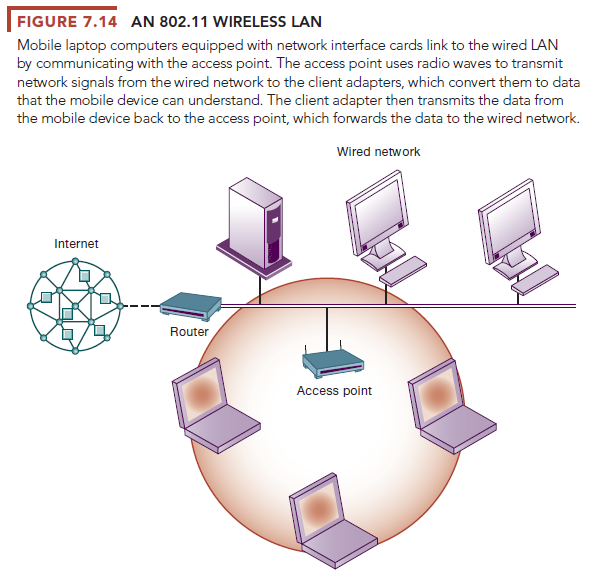An array of technologies provides high-speed wireless access to the Internet for PCs and mobile devices. These new high-speed services have extended Internet access to numerous locations that could not be covered by traditional wired Internet services and have made ubiquitous computing, anywhere, anytime, a reality.
1. Bluetooth
Bluetooth is the popular name for the 802.15 wireless networking standard, which is useful for creating small personal area networks (PANs). It links up to eight devices within a 10-meter area using low-power, radio-based communication and can transmit up to 722 Kbps in the 2.4-GHz band.
Wireless phones, pagers, computers, printers, and computing devices using Bluetooth communicate with each other and even operate each other without direct user intervention (see Figure 7.13). For example, a person could direct a notebook computer to send a document file wirelessly to a printer. Bluetooth connects wireless keyboards and mice to PCs or cell phones to earpieces without wires. Bluetooth has low power requirements, making it appropriate for battery-powered handheld computers or cell phones.
Although Bluetooth lends itself to personal networking, it has uses in large corporations. For example, FedEx drivers use Bluetooth to transmit the delivery data captured by their handheld computers to cellular transmitters, which forward the data to corporate computers. Drivers no longer need to spend time docking their handheld units physically in the transmitters, and Bluetooth has saved FedEx $20 million per year.

2. Wi-Fi and Wireless Internet Access
The 802.11 set of standards for wireless LANs and wireless Internet access is also known as Wi-Fi. The first of these standards to be widely adopted was 802.11b, which can transmit up to 11 Mbps in the unlicensed 2.4-GHz band and has an effective distance of 30 to 50 meters. The 802.11g standard can transmit up to 54 Mbps in the 2.4-GHz range. 802.11n is capable of transmitting over 100 Mbps. Today’s PCs and tablets have built-in support for Wi-Fi, as do the iPhone, iPad, and other smartphones.
In most Wi-Fi communication, wireless devices communicate with a wired LAN using access points. An access point is a box consisting of a radio receiver/ transmitter and antennas that links to a wired network, router, or hub.
Figure 7.14 illustrates an 802.11 wireless LAN that connects a small number of mobile devices to a larger wired LAN and to the Internet. Most wireless devices are client machines. The servers that the mobile client stations need to use are on the wired LAN. The access point controls the wireless stations and acts as a bridge between the main wired LAN and the wireless LAN. The access point also controls the wireless stations.
The most popular use for Wi-Fi today is for high-speed wireless Internet service. In this instance, the access point plugs into an Internet connection, which could come from a cable service or DSL telephone service. Computers within range of the access point use it to link wirelessly to the Internet.
Hotspots are locations with one or more access points providing wireless Internet access and are often in public places. Some hotspots are free or do not require any additional software to use; others may require activation and the establishment of a user account by providing a credit card number over the web.

Businesses of all sizes are using Wi-Fi networks to provide low-cost wireless LANs and Internet access. Wi-Fi hotspots can be found in hotels, airport lounges, libraries, cafes, and college campuses to provide mobile access to the Internet. Dartmouth College is one of many campuses where students now use Wi-Fi for research, course work, and entertainment.
Wi-Fi technology poses several challenges, however. One is Wi-Fi’s security features, which make these wireless networks vulnerable to intruders. We provide more detail about Wi-Fi security issues in Chapter 8.
Another drawback of Wi-Fi networks is susceptibility to interference from nearby systems operating in the same spectrum, such as wireless phones, microwave ovens, or other wireless LANs. However, wireless networks based on the 802.11n standard solve this problem by using multiple wireless antennas in tandem to transmit and receive data and technology called MIMO (multiple input multiple output) to coordinate multiple simultaneous radio signals.
3. WiMax
A surprisingly large number of areas in the United States and throughout the world do not have access to Wi-Fi or fixed broadband connectivity. The range of Wi-Fi systems is no more than 300 feet from the base station, making it difficult for rural groups that don’t have cable or DSL service to find wireless access to the Internet.
The Institute of Electrical and Electronics Engineers (IEEE) developed a family of standards known as WiMax to deal with these problems. WiMax, which stands for Worldwide Interoperability for Microwave Access, is the popular term for IEEE Standard 802.16. It has a wireless access range of up to 31 miles and transmission speed of 30-40 Mbps (and up to 1 Gbps for fixed stations).
WiMax antennas are powerful enough to beam high-speed Internet connections to rooftop antennas of homes and businesses that are miles away. Cellular handsets and laptops with WiMax capabilities are appearing in the marketplace. Mobile WiMax is one of the 4G network technologies we discussed earlier in this chapter.
Source: Laudon Kenneth C., Laudon Jane Price (2020), Management Information Systems: Managing the Digital Firm, Pearson; 16th edition.

I always spent my half an hour to read this webpage’s content all
the time along with a cup of coffee.